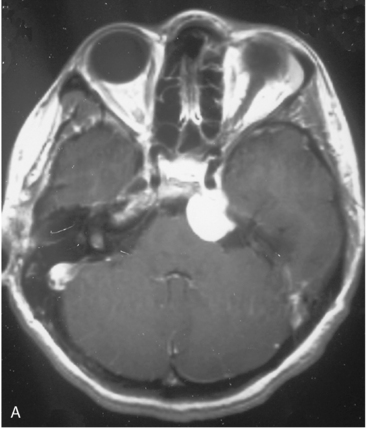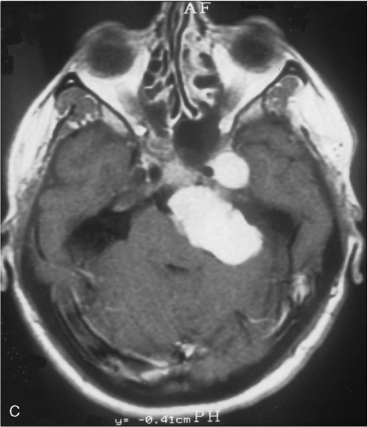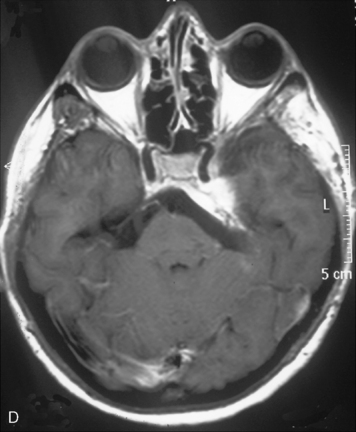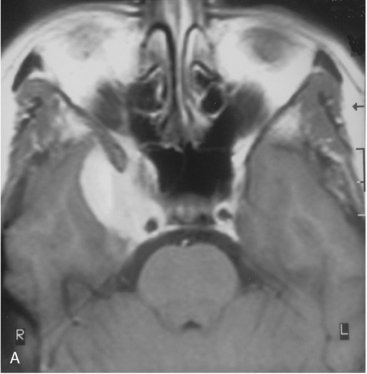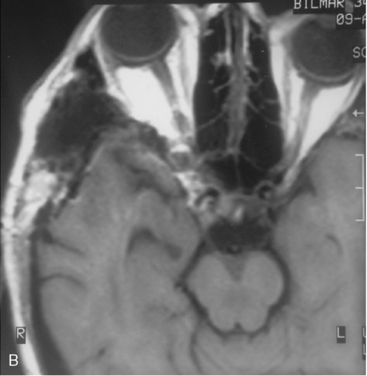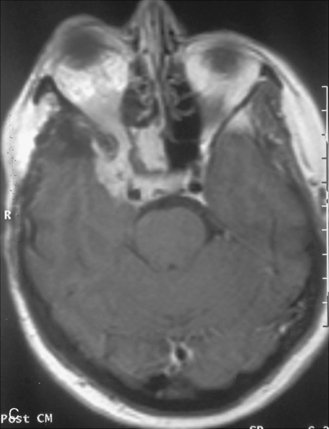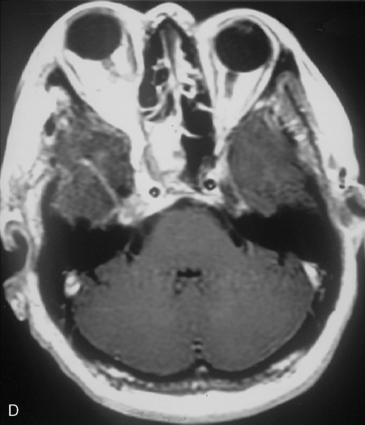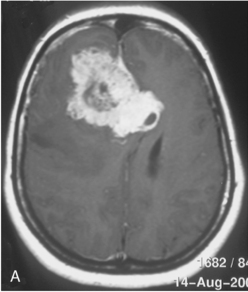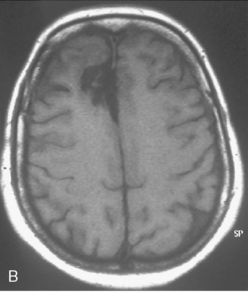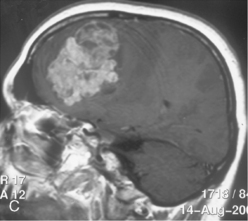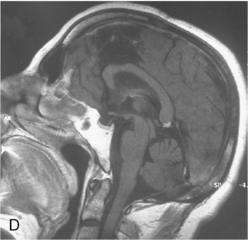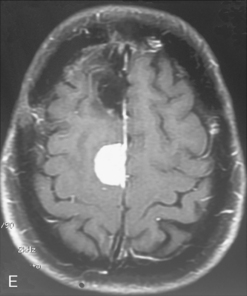CHAPTER 58 Recurrence of Meningiomas and Its Management
INTRODUCTION
For benign meningiomas, clinically relevant recurrences are common during the patients’ lifetimes. Seemingly complete removal is achieved in 64% to 97% of operated patients1–5 but is curative only in 68% to 80%.1,3,6,7 After surgery of any tumor there is a risk of recurrence. Common sense holds that the risk of recurrence depends on the extent of removal, but also that biological features such as growth rate influence how rapidly a recurrence occurs. Radical surgery with a large margin can be achieved only rarely in the central nervous system. The risk of a minute residual is relatively high and, subsequently, biological variables have a relatively large influence on whether patients risk a tumor recurrence.
Clinically, the “radicality” of meningioma surgery is either defined by the surgeon’s intraoperative assessment,8 which is clearly subjective, or from a postoperative radiological examination.2 Neither strategy is sufficient to exclude completely the presence of residual tumor cells, and pathology exams are only rarely utilized to evaluate the extent of tumor removal. We recently evaluated a series of parasagittal meningiomas and detected residual microscopic meningioma growth in the dural resection margins in 41% of “radical” Simpson grade 1 classed operations.9 The distinction between a recurrence and progressive growth is not of major importance. We cannot be sure whether we are detecting tumor progression or true recurrences. Circumstantial evidence suggests that most recurrences are actually progressing tumor residuals while de novo recurrences occur more rarely. Typically, we refer to returning tumor growth as a “recurrence” whenever initial surgery included radical tumor removal as assessed intraoperatively (Simpson grades 1–2) and postoperative radiologic examinations failed to reveal a residual tumor. Simpson defined only grades 1–2, which included removal or coagulation of the tumor origin as “radical,” while grade 3 constitutes only total removal without managing the tumor origin.8 The intraoperative assessment is subjective and largely influenced by the surgeon’s experience and surgical tactics. Subsequently, the recurrence rates of different series will reflect biological tumor features, surgical goals, and experience; the boundary between recurrence and progression will never be sharp. It has been suggested that “all meningiomas may recur, if the follow-up is long enough,” hence a thorough understanding of the natural history and sufficient follow-up are of utmost importance when treating patients who are expected to have a long life expectancy after treatment.
Extra-axial metastases are rare but still seen regularly, and 60% occur in histologically benign meningiomas. The most common sites are lung, abdominal viscera, vertebral bodies, and other bone sites (reviewed by Drummond10 and in Chapter 60).
FREQUENCY AND CONSEQUENCES OF RECURRENCES
The recurrence rate 20 years after seemingly radical surgery (Simpson grades 1–2) for benign meningiomas was at least 19% in a Finnish population-based study.6 Mirimanoff1 found a 32% recurrence rate after 15 years; Adgebite and colleagues7 found a 37% to 55% recurrence rate at 20 years and Stafford and colleagues3 quoted a 25% recurrence rate in 10 years. Our 18-year follow-up of cranial base meningiomas revealed a 9% to 14% recurrence rate following Simpson grade 1 surgery.9
Subtotal surgery (Simpson grade 4) led to recurrence/progression rates of 81% to 85% in 15 to 18 years.1,9,11 A true long-term study of parasagittal meningiomas (Mathiesen, unpublished) showed that Simpson grade 4 surgery led to progressive growth in all patients who survived for more than 10 years, that these patients needed additional surgery, and that only approximately 10% were alive and independent after 25 years. We have also evaluated long-term outcomes (mean 18 years) after surgery of cranial-base meningiomas. In this series, 69 patients underwent subtotal resection (Simpson grade 4), with 8% stable at follow-up, 10% retreated for progressive tumor growth, and 82% of whom died. Subtotal surgery thus carries a high risk of clinically relevant tumor progression in long-term perspective.
Recurrences are rarer after radical surgery, but their consequences are similar. Recurrence and progression of incompletely removed tumors is the major reason for excess mortality in patients who have a good condition after surgery.9,12,13 Another figure14 that described the impact of recurrences was the finding that olfactory meningiomas led to recurrences in 10% at 10 years and 25% at 20, and that 20% of the patients actually died from the recurrences.
Recurrences After Radiosurgery
Recurrences after radiosurgery have not been systematically studied, and the literature is ambiguous. The aim of radiosurgery is tumor control, which means that the tumor does not progress past a possible treatment-related swelling during the first year after treatment. A smaller proportion of meningiomas were reported to actually shrink during follow-up and long-term control rates were 90% to 95%, which would translate to the favorably low recurrence/progression rate of 5% to 10%.15–19
A difficulty in interpretation of these figures is the fact that best series include a number of small, circumscribed, sometimes incidental, meningiomas. Their growth rates before treatment were unknown, but it is likely that many of these tumors would have had an extremely low progression rate also without surgery. In this case, the causative role of radiosurgery is not obvious and it is probable that tumors with demonstrated growth would have less favorable responses. We have even seen the daunting progression rate of 50% in a subgroup of meningiomas that recurred or progressed during a 5.9-year follow-up after initial microsurgery.9
Grading and Rationale of Radicality
The relationship between “radicality” of surgery and recurrence rates was first analyzed and a classification scheme provided by Simpson in 1957.8 The Simpson grading differentiates surgery according to whether the tumor was only biopsied (grade 5), subtotally removed (grade 4), totally removed but without removal of the origin (grade 3), totally removed with coagulation of the origin (grade 2), or totally removed with removal of the dural origin and underlying bone (grade 1). The risk of recurrence increases with each grade and already mere coagulation of the dural origin instead of complete dural and bony removal doubles the number of future recurrences from 9% to 19%. The need to deal with the tumor origin was corroborated when the findings and figures were repeated by Chan and colleagues2 and Yamashita and colleagues.20
One rationale of the Simpson differentiation among removal of the bony origin, coagulation, or just removing the tumor is that meningiomas, as derived from the mesenchyme, possess a potential of growing invasively in mesenchymal tissues: bone and muscle. Only a limited number of meningiomas affect musculature. Thus, although muscular invasion may be difficult to remove as the dissection planes are poorly defined, the practical impact is limited. In contrast, a relevant relationship to the cranial bone is frequent. Hyperostosis and osteolytic changes at the bony origin are common and their significance has been debated. The hyperostosis is sometimes argued to be a reactive phenomenon, but frank tumor invasion appears to be more common when the actual histology is assessed.21–23 Osteolytic changes, which are rarer, clearly reflect tumor invasion.24
The fact that a benign tumor could recur in spite of radical removal was disturbing and sparked further investigations of tumor borders. Borovich and colleagues25,26 described isolated meningioma nests that surround the tumor origin and were detectable at distance from the visible tumor bulk. Simpson’s concept of radicality was expanded by Borovich and colleagues25,26 and Al Mefty and colleagues,27 who described a “grade 0 removal” for convexity meningiomas: a dural margin of 2 cm was removed after regular tumor removal; during an albeit short follow-up of 5.6 years grade 0 surgery did not lead to recurrences.
Simpson 4 Gamma
The Simpson classification is inadequate to describe radiosurgery. Pure radiosurgery may not need any specific classification, as the radiation is sufficiently quantified and defined through a dose plan. The situation is different when combining micro- and radiosurgery. The intentional upfront combination of two different meningioma treatments, microsurgery and radiosurgery, is different from subtotal surgery and from radiosurgery. The term “Simpson 4 gamma” was used for such a combination of tailored microsurgery and immediate radiosurgery for the residual in 3 months.28 The classification made sense when applied to meningiomas growing into venous sinuses. In a retrospective analysis of 100 patients with meningiomas that grew into large venous sinuses, Simpson grade 1 surgery led to a recurrence rate of 10%. Patients with deliberate nonradical surgery (Simpson grade 4) had a tumor recurrence rate of 72% while a combined treatment of upfront Gamma Knife ® radiosurgery after a tailored microsurgical resection (Simpson 4 gamma) allowed return to a low recurrence rate of 10%.
Interestingly, we found a major difference between a 90% control rate after upfront radiosurgery for a residual (Simpson 4 gamma) and a 50% control rate for secondary treatment of a demonstrated tumor recurrence. The figures may be influenced by a selection bias, but the actual progression rate for Simpson grade 4 was 73%, indicating that a selection bias could not explain the entire difference. An important factor in combining micro- with radiosurgery is the deliberate tumor tailoring for radiosurgery. Kondziolka and colleagues29 followed a series of patients with parasagittal meningiomas after radiosurgery and detected a 20% complication rate while we found no radiosurgical complications. The difference is that smaller volumes were targeted when radiosurgery was an integral part of a deliberate combined treatment strategy: Microsurgery was tailored to produce small tumor volumes that were suitable for safe radiation. Radiosurgical risk is strongly related to the radiated volumes and patients with larger tumors were included in the series by Kondziolka and colleagues.29
Location
The recurrence rates vary in different meningioma locations. Location affects the risk of recurrence in two ways. First, a readily accessible tumor is easier to remove radically than a tumor with growth onto or into venous sinuses or in the cranial base. A specific location probably represents a certain likelihood of radical surgery and a location is usually not a risk factor that is independent of surgical strategy, tactics, and experience. Typically, deep locations in the cranial base and locations where tumor grows into major vessels could be expected to pose specific problems with radicality and definition of tumor margins. Jääskeläinen and colleagues6 found that recurrence after seemingly complete removal was more likely in the sphenoid ridge and olfactory sites: the 20-year recurrence rates were 7% for suprasellar meningiomas, 18% and 21% for convexity and parasagittal locations, and 29% and 36% for sphenoid wing and olfactory meningiomas, respectively. The latter finding agrees with Philippon30 and Simpson.8 Petroclival locations are rarer, but constitute another cranial-base location with high recurrence rates12 (Fig. 58-1). The high frequency of subtotal surgery explains why tumor recurrence isrelatively common around the medial sphenoid wing and the cavernous sinus12 (Fig. 58-2). Meningiomas in close proximity of venous sinuses had a 10-year recurrence rate after radiologically radical removal of 40% versus 15%.31 Similarly, parasagittal meningiomas also carry a higher risk of recurrence8,12 (Fig. 58-3).
The findings differ slightly depending on whether a tumor is believed to be totally removed or whether a subtotal removal has been deliberately undertaken and on the experience of the surgeon. Typically, the degree of bone work to remove the entire tumor origin and to reach behind corners and into invaded canals affects radicality in the cranial base while bypass surgery and vascular reconstructions affect surgical tactics in tumors that affect large veins and arteries. Typically, sphenoid wing meningiomas that were believed to be radically removed, were found to recur at high rates.6,9 Cranial base approaches provide wide exposures for these cranial base tumors, comparable even to convexity meningiomas, allowing for more complete resections.
Spinal meningiomas were less studied. Elderly patients with spinal meningiomas had recurrence rates of 4% to 5%32,33 while the group younger than 50 years of age had a recurrence rate of 22%.32 Another technical aspect is the membranous, vascular, arachnoid-like extension that frequently surrounds meningiomas. It was described by Simpson8 as “thin, flat, fringe,” and it probably corresponds to the “dural tail” seen on imaging.34 This structure contains meningioma cells in approximately 50% of patients.
Second, the likelihood of aggressive behavior varies with location. The risk of aggressive or malignant features is highest in parasagittal and convexity locations. Interestingly, the risk of malignancy is three times higher in males than females35 and in addition, the sex distribution varies with location. Parasagittally and in the convexity two thirds of tumors are in females; in the cranial base three-fourths are in females and, finally, 9/10 spinal meningiomas are in females (Westerlund et al., unpublished).
Recurrences thus vary with the locations, but the main variable is still surgical radicality. If surgical techniques are chosen with the objective to be radical, which may not always be indicated if surgical risk increases, location loses its prognostic value. In a recent study of only Simpson grade 1 to 2 operations where radicality was carefully controlled, recurrences became independent of location.36
Timing of Recurrence
The median times to recurrence were stated to be 7.5 years for benign, 2.4 years for atypical, and 3.5 for anaplastic meningiomas.6 The time between surgery and recurrence depends on how much tumor was left and how rapidly it regrows, but the time to detection also includes the method and length of follow-up. A true long-term follow-up study is difficult to make and cannot be expected to be prospective. The fact that meningiomas are potentially curable although late recurrences have been described mandates knowledge of long-term outcomes of more than 20 years. The mean time to recurrences seems to be longer in studies with longer follow-up.9,30,37,38 Philippon had two groups of patients with recurrent tumor and either a 5- to 10-year or a 10- to 15-year follow-up30 and found not only that the time to follow-up was longer in the second group, but also that one third of the recurrences occurred after 10 years. In a study of 362 cranial base meningiomas,9 approximately 60% of all recurrences occurred in the interval 1 to 10 years and 40% between 10 and 20 years. Two true long-term series6,9 have a few patients with negative radiologic follow-up between 15 and 20 years, who subsequently developed tumors. A majority of recurrences occur early, with more than half of all diagnoses within 5 years,9,30,39 but the cumulative incidence of recurrence increased steadily up to 20 years without any signs of stabilizing to a plateau in the studies that actually followed the patients over a long term. It must be kept in mind that the group that can be affected by recurrences decreases steadily as occurrences occur or as patients die. It is thus reasonable to keep patients in radiologic follow-up beyond 20 years, although it appears reasonable to increase intervals between scanning.
One recurrence can be followed by additional ones, but the intervals to the next recurrence are not easily predictable. Mirimanoff and Böker found that in a majority of patients with multiple surgeries the time between multiple recurrences kept decreasing.1,40 In our analysis, we found that approximately one third of the patients had longer intervals, one third had similar, and only one third had a shortened interval between diagnoses of new recurrences.9
The other factor that affects timing is the mode of follow-up. Today, magnetic resonance imaging (MRI) is the tool of choice, as it is more sensitive and avoids unnecessary exposure to ionizing radiation. The available long-term studies were, however, initiated before common access to MRI and have initially utilized either pure clinical follow-up or computed tomography (CT) scanning. The sensitivity increases as imaging becomes more refined and subsequently any growing lesion would be detected earlier by more modern technology. MRI is more sensitive than CT, and CT imaging is more sensitive than clinical follow-up. Chan and colleagues2 found a mean time to recurrence of 5.7 years with clinical follow-up but only 2.9 years with CT scanning.
Biological Markers of Increased Recurrence Rates
Regarding age and sex, conflicting data have been published,7,41–44 but younger age and male sex appear to correlate with a higher incidence of recurrences. A younger age confers a relatively higher chance of a rapidly growing lesion, because it has, at least theoretically, had fewer years to grow. A gender effect is likely, as malignant meningiomas are more frequent in men than in women,35 but epidemiologic findings may vary with selection bias of different meningioma subgroups and their definition.
HISTOPATHOLOGY
Traditionally, beginning with Cushing and Eisenhart, the meningiomas were classified into subtypes depending on their microscopic appearance.45 These subtypes, however, had little prognostic value. Instead, the WHO classification has a high correlation to prognosis (Table 58-1). WHO histopathologic classification divides meningiomas into benign (WHO grade I), aggressive (WHO grade II), or anaplastic (malignant; WHO grade III) variants.46 Certain histopathologic criteria (Table 58-2) are associated with a more aggressive behavior. WHO grade II and III tumors are diagnosed when histopathologic features such as brain invasion, sheeting, macronucleoli, hypercellularity, necroses, nuclear atypia, small cells, and a high number of mitoses are detectable.46,47 In addition, some of the rarer histologic subtypes may show aggressive behavior: the rare tumors that are classified as atypical, clear cell, chordoid, rhabdoid, or anaplastic meningiomas are graded as II or III.
TABLE 58-1 Meningiomas with different histopathological characteristics
| Meningiomas with low risk of recurrence and/or aggressive growth | |
| Meningothelial meningioma | WHO grade I |
| Fibrous/fiberblastic meningioma | WHO grade I |
| Transitional (mixed) meningioma | WHO grade I |
| Psammomatous meningioma | WHO grade I |
| Angiomatous meningioma | WHO grade I |
| Macrocystic meningioma | WHO grade I |
| Secretory meningioma | WHO grade I |
| Lymphoplasmacyte-rich meningioma | WHO grade I |
| Metaplastic meningioma | WHO grade I |
| Meningiomas with greater risk of recurrence and/or aggressive growth | |
| Atypical meningioma | WHO grade II |
| Clear cell meningioma (intracranial) | WHO grade II |
| Chordoid meningioma | WHO grade II |
| Rhabdoid meningioma | WHO grade III |
| Papillary meningioma | WHO grade III |
| Anaplastic (malignant) meningioma | WHO grade III |
| Further: Meningiomas of any subtype or grade with high proliferation index and/or brain invasion. | |
TABLE 58-2 WHO criteria for meningioma grading
WHO Grade I
About 80% of all meningiomas are slow-growing tumors of WHO grade I. Any histologic variant is compatible with WHO grade I, except for the chordoid, clear-cell, papillary, and rhabdoid meningiomas, which are consistently associated with more aggressive clinical features and higher WHO grades. The histologic variants most commonly diagnosed in pathology specimens are meningothelial, fibrous, and transitional meningioma. After gross total resection, benign meningiomas are associated with 5-year recurrence rates of only 5%.47 They have similar clinical behavior in spite of the fact that they have a striking difference in their relation to the “meningioma chromosome,” chromosome 22. The most frequent genetic aberration in meningiomas, inactivation of the NF2

